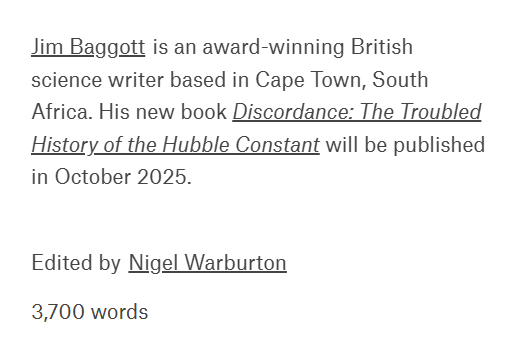The Big Bang's big gaps

The current theory for the origin of the Universe is remarkably successful yet full of explanatory holes. Expect surprises
https://aeon.co/essays/why-might-the-big-bang-theory-be-in-crisis-very-soon
 The NASA engineer Ernie Wright in front of the first six flight-ready primary mirror segments of the James Webb Space Telescope in 2011. Photo courtesy NASA
The NASA engineer Ernie Wright in front of the first six flight-ready primary mirror segments of the James Webb Space Telescope in 2011. Photo courtesy NASA

Did the Universe have a beginning? Will it eventually come to an end? How did the Universe evolve into what we can see today: a ‘cosmic web’ of stars, galaxies, planets and, at least on one pale blue planet, what sometimes passes for intelligent life? Not so very long ago, these kinds of existential questions were judged to be without scientific answers. Yet scientists have found some answers, through more than a century of astronomical observations and theoretical developments that have been woven together to give us the Big Bang theory of cosmology.
This extraordinary theory is supported by a wide range of astronomical evidence, is broadly accepted by the scientific community, and has (a least by name) become embedded in popular culture. We shouldn’t get too comfortable. Although it tells an altogether remarkable story, the current Big Bang theory leaves us with many unsatisfactorily unanswered questions, and recent astronomical observations
threaten to undermine it completely. The Big Bang theory may very soon be in crisis.
To understand why, it helps to appreciate that there is much more to the theory than the Big Bang itself. That the Universe must have had a
historical beginning was an inevitable consequence of concluding that the space in it is
expanding. In 1929, observations of distant galaxies by the American astronomer Edwin Hubble and his assistant Milton Humason had produced a remarkable result. The overwhelming majority of the galaxies they had studied are moving away from us, at speeds directly proportional to their distances. To get some sense of these speeds, imagine planet Earth making its annual pilgrimage around the Sun at a sedate orbital speed of about 30 kilometres per second. Hubble and Humason
found galaxies moving away at tens of thousands of kilometres per second, representing significant fractions of the speed of light.

Hubble’s speed-distance relation had been anticipated by the Belgian theorist Georges Lemaître a few years before and is today known as the Hubble-Lemaître law. The constant of proportionality between speed and distance is the
Hubble constant, a measure of the rate at which the Universe is expanding. In truth, the galaxies are not actually moving away at such high speeds, and Earth occupies no special place at the centre of the Universe. The galaxies are being
carried away by the expansion of the space that lies between us, much as two points drawn on a deflated balloon will move apart as the balloon is inflated. In a universe in which space is expanding, everything is being carried away from everything else.
snip



